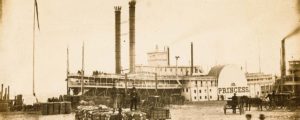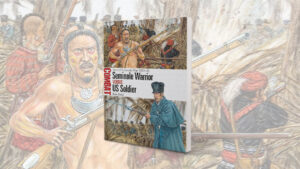After an Indian named ‘Poker Tom’ was murdered in California’s Mono County in 1891, fellow Paiutes exacted revenge against a Chinese merchant while white townspeople stood and watched.
Piteous cries for mercy alternated with despairing shrieks as a mob dragged the Chinese businessman down the main street of Bridgeport, California, on the afternoon of June 9, 1891. Revenge-minded Paiute Indians were doing the dragging—a sight eyewitnesses would never forget—but white “frontier justice” was behind the lynching. “Women fainted, and some were so overcome by nervous prostration that in some cases life was in peril,” Mono County deputy recorder Richard Barnard wrote in a letter printed 10 days later in the San Francisco Chronicle. “Some of the little girls and boys who happened to hear the fearful cries of the Chinaman became so prostrated with nervous fear as to become a source of serious anxiety. Even strong men had their nervous systems so shocked as to make them sick.”
At the heart of the Bridgeport incident—which Barnard described as “one of the most horrible violations of laws of a civilized community that the criminal records of this county can show”—was a macabre clash of social, ethnic and spiritual values. Newspaper headlines screamed all about it. The San Francisco Chronicle ran these banners:
THE MONO LYNCHING
Two Lawyers Responsible for It They Secured the Coolie’s Property The Indians Dragged the Shrieking Victim from the Courtroom
Over in Carson City, Nevada, the Morning Appeal went for shock value:
HORRIBLE IF TRUE
Nevada Chinaman Selling Human Flesh To the Indians
Elsewhere in Nevada, the Virginia City Chronicle probably summarized the situation best:
BLOOD FOR BLOOD
Frightful End of a Bridgeport Chinaman Suspected of Murdering an Indian
The bizarre events that June 9 in the county seat were set in motion by a game of poker gone wrong—its deadly outcome indeed spawning a blood-for-blood scenario.
Sometime in early May 1891, a big Paiute known as “Poker Tom” left the Walker River Reservation in Nevada and showed up in Bridgeport. Tom, as his nickname suggests, had come to town to play stakes poker. He found a money game with Chinese merchant Ah Quong Tai (aka Tia). It would be Poker Tom’s last round.
When Tom didn’t return home, his fellow Paiutes started to worry. They knew him to be an expert poker player who often carried on his person considerable sums, mostly winnings from his own people. A party of friends from Nevada, headed by Chief Captain Charlie, traveled to Bridgeport to see what had happened to Tom. On Tuesday, June 2, they held a powwow with Captain Jim of the Bridgeport Paiutes to decide on a course of action.
The two captains and their men questioned local Paiutes but failed to find any trace of Tom or any solid leads on who might have “got away” with the gambling man. They did, however, pick up enough tidbits here and there to suspect fellow Indians, as well as Ah Quong Tai.
The party next mounted an extensive search for Tom, aided by Captain Jim and Mono County Sheriff Michael J. Cody. They turned up Tom’s saddle blanket in Bryant’s Field, north of town. Soon after, they found his horse and saddle. Other Indians arrived in town to help, some from Bodie, Calif., and others from neighboring Mono Lake, led by their chief, Captain John.
On Thursday, June 4, Captain Charlie called a second powwow and expanded the search to the East Walker River, which flows through Bridgeport to the northeast, passing within yards of Ah Tai’s store. Those searchers on the river patrol soon found Poker Tom’s waterlogged black jacket, snagged in the current near the local dam. Sheriff Cody held the jacket in evidence. Meanwhile, the Paiutes dragged the river downstream. On Saturday, June 6, Tom turned up—or at least part of him. “Hunting every nook and corner in the country,” the Virginia City Chronicle reported, “they found the upper part of Tom’s body in the river. The head, legs and arms had been cut off, and the breastbone was sawed apart and the entrails taken out, and the body placed in a brine of salt water until thoroughly pickled. It is said that Ah Tai gave the Indians a ‘big eat’ a few days after the poker game. There were some choice tidbits on the table, which the Indians ate with great relish, and they [now] believed that the crafty Chinaman made a fricassee of the head and heart of poor Tom.”
Several Indians recalled seeing blood on the floorboards at Ah Tai’s store, where witnesses last saw Poker Tom playing cards. Sheriff Cody and Captain Charlie led a search of the store for evidence. At first, the lawman saw nothing suspicious, but some keen-eyed Indians pulled up several boards and found extensive blood smears. Then, in a back room, Cody noticed sheets of clean wrapping paper pasted over the existing wallpaper. Removing the wrapping paper, he discovered additional bloodstains.
According to the Virginia City Chronicle’s earliest version of the card game gone sour, “the Indian, it is said, won $200 and ‘jumped’ the game.” But Richard Barnard’s letter in the June 19 San Francisco Chronicle suggested otherwise: “On the evening of the day the body was found, the Chinaman came and asked the protection of the sheriff and asked that he be placed in jail. At this time, Ah Tai made a confession to Francis Hanson, who is a lawyer and was acting as the Chinaman’s attorney, bookkeeper and adviser, as follows: That he (Ah Tai) and the Indian had played cards, the Chinaman winning $54 and breaking the Indian; that the Indian wanted his money back, but the Chinaman refused and requested the Indian to leave his house, but Poker Tom refused. They then grappled, and the Indian was getting the best of Ah Tai, when the Chinaman picked up a club and struck him over the head; that the Indian still pursued him, when the Chinaman struck him twice more over the head and killed him; that he then cut up the body of the Indian and carried the pieces of the Indian and put them in the river.” Attorney Hanson called upon Mono County tax collector Maurice P. Hayes as a witness and had Ah Tai repeat his confession.
Ah Tai was much smaller than Poker Tom and could not lift the body, so he dragged it to a rear bedroom and rolled it beneath his bed. The dining room floor was covered with blood, and the merchant scrubbed it several times that night. By the third night, Ah Tai feared his regular customers would detect the odor of decay, so he dismembered the remains and salted the body to stop further putrefaction. He first thought to disperse the body parts a piece at a time but again feared discovery. Whether or not he then served parts of the dead man as food, the torso was the only part of Poker Tom ever found.
Ah Tai counted on attorney Hanson for counsel. In payment, the lawyer asked the merchant for the mortgage on his store, valued at about $400, and a bill of sale for his personal property. Since his arrival in Bridgeport in 1888, Ah Tai had worked hard to build a modest general store and restaurant business. He sold rice and tea to the Chinese working the Dog Town placers, food and illegal whiskey to the local Indians and other supplies to the sheep men. The merchant gave his lawyer the mortgage but refused to surrender his personal property. Hanson faded from the trial scene once he had secured Ah Tai’s property, and two other lawyers stepped forward. Attorneys William O. Parker and J.C. Murphy offered their services to Ah Tai, and he engaged them—for a $1,000 fee if they obtained an acquittal, $500 if they failed. Ah Tai reluctantly loaned Parker and Murphy the key to his store so the two attorneys might satisfy themselves he owned enough merchandise to secure their fees. While the merchant sat in jail, Parker and Murphy valued his goods at between $2,000 and $3,000, then divvied up the stock and removed it to their respective houses.
On Sunday, June 7, the coroner called a jury to investigate the circumstances behind the death of the person whose torso turned up in the river. Hanson and tax collector Hayes testified to Ah Tai’s confession. Then the coroner called Ah Tai. According to the San Francisco Chronicle, the merchant changed his story, testifying that he and Poker Tom had played cards for only 20 minutes, after which Tom went home, and he went to bed. The jury took Ah Tai to view the victim’s remains. The merchant claimed he had never before seen the torso and could not tell what it was but that it looked like “mutton.” The jury formally charged Ah Tai with murder and returned him to jail, this time as a prisoner.
It was then the wheels of justice began to wobble. The coroner’s jury adjourned, and an official read its verdict to all present, including Richard Barnard. But when Barnard sought the transcript the following day, it had disappeared. He elaborated in his letter to the San Francisco Chronicle: “I went to the county clerk, auditor and recorder and ex-officio clerk of the Superior Court, whose deputy I am, and asked him if the verdict of the coroner’s jury had been given to him for file, as I desired a verbatim copy of it. He said he had not seen it. I then went to the justice of the peace, before whom the Chinaman was brought for his preliminary examination, and asked him if the verdict had been filed with him. He referred me to his clerk, Ben H. Miller, who also officiated as clerk of the coroner at the inquest. He also gave me to understand that he knew nothing about its whereabouts. This is only one of the peculiar proceedings connected with this affair.”
That same day, Monday, June 8, Ah Tai was brought before Justice of the Peace Thomas Fales for a preliminary examination, but the defendant’s counsel failed to appear. After a long wait, Parker finally showed up—so drunk that Justice Fales adjourned the court until the following day to allow Parker to sober up. Doubtless, these delays made little sense to outside observers, particularly the gathered Paiutes, who were becoming increasingly agitated. About 3 p.m. a formidable reinforcement of mounted Indian police from the Walker River Reservation rode into town, all well armed with Winchester repeating rifles and revolvers. The Paiutes threatened to seize the accused murderer from jail and cut him to pieces.
Barnard described the scene: “The Indians who had been here previous to this reinforcement were for some days encouraged by some of the white men, among whom were men of business and property, to make a fight and take Ah Tai out of jail and finish him. Even the chairman of the Board of Supervisors of the county, who was present during the crisis and one of the advisers to turn the Chinaman loose, did not try to influence or intimidate the officers of law into performing their official duties.”
Sheriff Cody, whom the Paiutes called “White Chief,” was, through great effort, able to pacify the Indians that afternoon. But Bridgeport had become an armed camp. Whole families of whites hurried to hotels for safety. A rumor circulated that at midnight the Indians, assisted by some whites, would attack the jail and grab the Chinese prisoner. Cody’s house was attached to the jail, so he secured his family at the Leavitt House (now the Bridgeport Inn). Six men offered to help the sheriff defend the jail. Several whites threatened to have the Indians burn those volunteers out of their homes, while others said they would gladly help the Indians murder any white man who would help protect the prisoner. Regardless, Sheriff Cody and his little squad stayed up all night, and no attack came. “All through the night, the Indians kept a guard of 20 men around the courthouse [jail],” the Virginia City Chronicle reported, “fearing that the Chinaman would get away in the night.” The county jail, the courthouse and the justice court were all in close proximity, the latter upstairs from the Brick Saloon (currently Ken’s Sporting Goods). Saloons’ second stories often doubled as justice courts in the Old West.
“There is great excitement there,” the Morning Appeal stated, “and when the Appeal’s informant left, the Indians were gathering to clean out the Chinese camp.” That reference was to the old part of town, abandoned by whites in favor of sites near the new courthouse. Several Chinese residents had moved into the buildings left vacant east of the river on Court Street. Ah Tai’s store, a simple sideboard shanty, stood among them.
The Paiutes might have been less furious over Poker Tom’s demise had he not been dismembered. The missing body parts violated their belief in a whole-body burial. In order for a person’s spirit to pass into the afterlife, they believed, it must be able to return to Mother Earth, where the body rested. Offended by Ah Tai’s actions, the Indians agitated for his dismemberment to prevent his spirit from returning. Those patrons of Ah Tai’s eatery who believed they had unwittingly engaged in cannibalism added fuel to the fire of revenge.
Meanwhile, white townspeople lobbied behind the scenes to manipulate the authorities. On the evening of June 8, several men of property mustered all manner of argument to convince the deputy district attorney and justice of the peace they had no case, there could be no conviction, and, if the Chinese prisoner were put on trial, it would just cost the county a lot of money. They urged that the prisoner be discharged and left to his fate at the hands of the enraged Indians.
The preliminary examination began the next morning, Tuesday, June 9, before Justice Fales. Ah Tai was present under the charge of a deputy constable. Parker and Murphy appeared as counsel for the defendant. A deputy district attorney represented the people. The defense had requested the examination be conducted behind closed doors, so an educated Indian known as Lieutenant Wilson stationed himself at the foot of the justice court stairway with fellow tribesmen. By 1 p.m. tax collector Hayes had testified again regarding Ah Tai’s confession and shared a few other things the defendant had said: “[That he] was afraid to notify the authorities…because the Indians would all know it and kill him…[that he] wouldn’t kill anybody for the sake of money; he was doing business here, and it wouldn’t do.”
County physician Thomas A. Keables testified as to the condition of the remains. The person who dismembered the body had used a keen knife and a fine-toothed saw and then preserved the flesh in a solution of chloride of lime and ammonia. Nothing remained below the thoracic cavity. Other than stating the parts were from an adult, he could not tell whether the victim was male or female and certainly could not identify the remains as those of Poker Tom. The prosecution closed.
Parker rose to address the court. “Counsel for the defendant moves the court to discharge the defendant upon the following grounds: First, there is no evidence to show that an Indian by the name of Poker Tom has been murdered. Second, the evidence for the prosecution shows that they do not know whether the remains found are those of a man or woman. Third [in reference to the missing coroner’s verdict], there has been no testimony taken before this court as required by law.” That was enough for Justice Fales; he quickly ordered Ah Tai discharged for want of sufficient evidence.
Parker told his client he was free to go, but Ah Tai refused to leave, rightly believing the Indians would kill him. He offered to pay $5 a day per man for a posse to protect him. Murphy left court to find Sheriff Cody and have Ah Tai jailed until a bodyguard could be secured, if such was to be had. A court official told the deputy constable to inform the waiting Indians that Ah Tai was being held for trial. But as he descended the stairs, the constable considered the consequences of lying to the Paiutes and instead admitted to Lieutenant Wilson that Ah Tai had been acquitted. Moments later four Indians burst through the courtroom door. Justice Fales, Ah Tai and Parker were the only ones present. One of the Indians told Ah Tai he wanted him and seized him by the wrist. Ah Tai grabbed Parker’s arm with one hand and hugged him around the waist, begging his lawyer to save him. The justice demanded the intruders to do nothing in the courtroom. The Indians then pried Ah Tai away from Parker and rushed him downstairs into the street.
Outside, the captors fired a single shot. At that prearranged signal, hundreds of Indians swarmed into Main Street from the alleys and fields. Ah Tai pleaded loudly for his life as the mob dragged him through the center of town. Sheriff Cody’s own daughter, Ella, and her friends ran from her 9th birthday party to see what all the commotion was about. Like others, she ventured no farther down Main Street than the courthouse. “We ran to the front of the courthouse yard and saw Ah Tai being dragged up the street by the wild, howling mob,” she later recalled. She dashed inside the courthouse. “From my vantage point on the second floor, I saw the final act,” she said. (The little girl grew up to become Mrs. Ella M. Cain, a Bodie schoolmarm, who relived the fear and horror of that spectacle well into her 80s.) The execution of Ah Quong Tai took place in the open, near George “By” Day’s field. Whites peered from windows to witness the horrible sight. Barnard recalled the gruesome killing: “There, in the presence of the Indians and in view of some of the white boys and men of the town, his arms, legs and head were cut off, his entrails were cut out, and he was otherwise mutilated in a manner too horrible to recite.”
The Virginia City Chronicle reiterated Barnard’s account, adding that Ah Tai was told to dance during the torture but that he simply uttered frightful laments. Another report described Ah Tai’s scalping, after which one of his assailants swung the bloody trophy by the long braided queue and sailed it over a fencepost, where it dangled until the final burial. The Indians retreated to their camp on the east edge of town, leaving their victim’s remains scattered about on the ground. Later, at the request of Dr. Keables, who pronounced it a health hazard, Mono Lake Chief Captain John returned with a few of his men to gather the scattered remains in a blanket and bury them in Sinnamon’s Field.
The San Francisco Chronicle opined that the case was a conspiracy and that whites had egged on the Paiutes solely to take possession of the Chinaman’s property. In a parting shot in the Chronicle story, Barnard said, “The prominent part taken by some of the white men in urging the Indians on, and their threats made against parties who were desirous of aiding the sheriff in this matter, have engendered a feeling that may at any time lead to other tragedies.”
Months after the event, on December 5, 1891, the Bridgeport Chronicle-Union reported the grand jury finding that Ah Tai had murdered Tom and that the court had received no incriminating evidence from the coroner’s jury. But it also found that the court had erred in discharging Ah Tai from custody, that the deputy district attorney had erred in failing to object to that dismissal, and that the defense attorneys had erred in releasing Ah Tai against his will. The jury had called several Paiutes to testify, but they gave only a single well-rehearsed mantra: “Our chief say, ‘No talk.’ Tom dead. Tai dead. Pretty good.”
The grand jury censured Sheriff Cody for failing to protect Ah Tai from a certain death and for not attempting to arrest his murderers. Most citizens of Bridgeport supported Cody’s efforts to keep the peace, despite the grand jury findings. From the outset, the sheriff had repeatedly counseled the Indians to remain calm. But in the wake of Ah Tai’s killing, Cody feared a massacre of whites if he touched off the heavily armed Paiutes by making arrests. He had a duty to protect a civilian population of roughly 100 men, women and children; estimates of the number of Indians ran from 300 to 400. Cody made the informed choice of a peace officer, while the Paiutes, their lust for revenge sated, went quietly on their way.
National Park Ranger Lee J. Shackelton, of Mariposa, Calif., found this story in the scrapbook of James W. Orndorff, his late great-grandfather. Suggested for further reading: The Story of Early Mono County, by Ella M. Cain; Mono Diggings, by Frank S. Wedertz; Mono County, by Raymond M. Smith; and Pioneers of Mono Basin, by Margaret Calhoun.
Originally published in the December 2009 issue of Wild West. To subscribe, click here.




